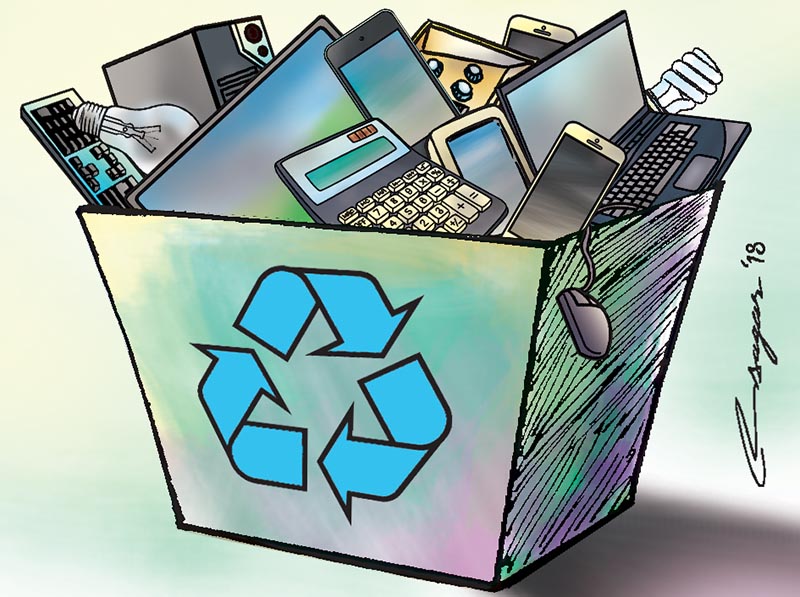E-waste pollution: Threat to human health
When electronic and electric devices are dumped in land improperly, hazardous chemicals seep into environment, contaminating land and water; and when they are burnt for recycling, they release highly toxic fumes into the air
When we talk about pollution, our focus is mostly on the contamination of air and water, which perhaps is due to our everyday experience, as we breathe in dust and smoke and drink contaminated water. People either do not know or talk very less about pollution caused by electronic and electric waste (e-waste), which is no less hazardous than any other pollutants we know about.
The waste that comes from electrical and electronic equipment and appliances that are discarded without any intent to reuse merits serious attention from the public as well as from the government.
To begin with, e-waste contains many seriously hazardous chemical components such as lead, mercury, cadmium and chromium. When electronic and electric devices are dumped in the land improperly, the hazardous chemicals seep into the environment, contaminating land and water; and when they are burnt for recycling, they release highly toxic fumes into the air.
The impact of these contaminations on human health is damaging and irreparable. They, for instance, can cause long-term problems such as neurological and endocrinal disorders, and even cancer. Children are more vulnerable to these contaminants.
The World Health Organisation (WHO) has warned about the greater vulnerability of children to these contaminants, along with the impact on the general population. The reason children are more vulnerable is that their intake of air, water and food in proportion to their weight is significantly greater compared to the adults.
A research conducted by students of a medical college in China found that children living near e-waste recycling towns such as Guiyu had their lead level in blood highly elevated. Even more serious is that the elevated level of lead in the blood is common among children in such areas. Lead contamination from e-waste processing appears to have reached the level considered a serious threat to children’s health. Needless to say how harmful elevated level of lead is on human health in general and children’s health in particular, as it affects, liver, kidney and bone and causes irreversible brain injury, and even death.
The problem of e-waste is becoming increasingly harder to solve for its rapid expansion. The consumer electronic and electrical appliances, according to the United Nations, are the fastest growing sector of municipal solid waste in both developed and developing countries, which is the consequence of the conspicuous increase in mass production and consumption of devices such as cellphones, refrigerators, computers, washing machines and microwaves among others.
The digital revolution provided a variety of products which are not only economical but also easy to use, which, therefore, have invaded urban households on a huge scale. The fast pace of innovation along with the increasing affordability of electronic goods due to economic growth has led to the rapid turnover of these consumer goods and, therefore, enormous amounts of e-waste.
The trend of multiple device ownership is one of the leading causes driving the generation of e-waste.
The Global E-waste Monitor 2017 said that the amount of global e-waste generation was expected to reach 49.8 million tonnes in 2018 with an annual 4-5 per cent growth. What is worrisome is that e-waste, as experts foresee, will increase to 52 .2 million metric tonnes by 2021.
What is alarming for us is that developing countries are at a greater risk as they lack proper e-waste management system, and, even worse, they have become dumping sites for e-waste produced in developed countries.
According to the UN, 80 per cent of e-waste produced in high-income countries (Europe and North America) is shipped (often illegally) to low and middle-income countries: millions of mobile phones, laptops, tablets, toys, digital cameras and other electronic devices are destined flood developing countries with e-waste.
Nepal is facing a worrisome situation.
Due to rapid influx and consumption of electronic and electrical items in recent years, a huge amount of e-waste is being dumped into the land now.
The government of Nepal does not seem to have identified and recognised the problem of e-waste, let alone formulate policies to deal with it. This is aggravated by the fact that neither the public in general nor the educated segment, in particular, is aware of the problem. Those who are informed about the problem are either clueless or pessimistic as to what to do. Moreover, hardly has this issue found any place in political, academic and media discourse. What is more, in our case, is that e-waste contamination is likely to have more severe consequences.
As a huge part of the urban and rural population in Nepal uses underground water, it is likely that they are consuming contaminated water; and the water will continue to be contaminated in the future. Moreover, e-waste is being dumped improperly and carelessly into the river, which is adversely affecting the flora and fauna and the people who depend on river waters for numerous purposes. In a nutshell, e-waste calls for immediate and effective resolution and action on the part of the government as well as the public.
Dahal is pursuing MPhil in Development Studies at School of Education, Kathmandu University






